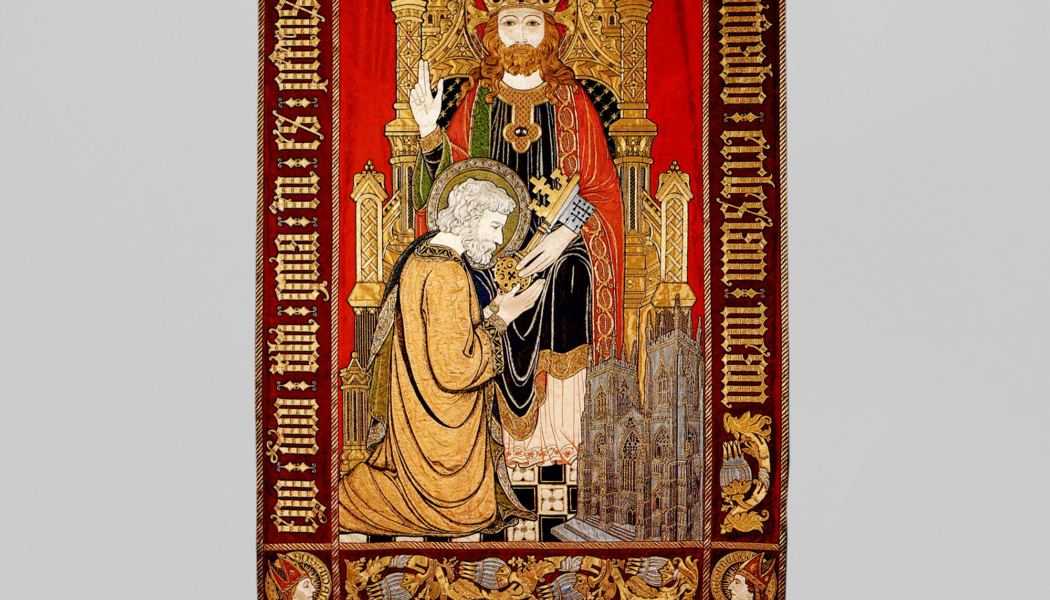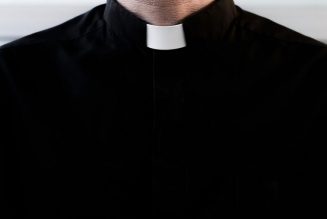Cecilia Rexworthy’s unexpected journey to the upper echelons of ecclesiastical couture began with a few basic keywords typed into a Google search: nice white silk fabric church.
This was five years ago, when the Catholic mom of four, a former book editor living on the outskirts of London, was making a switch to a new career as a needleworker and needed special material for some embroidery work she was doing for her parish.
The search results led her to 7 Tufton St., London, the unassuming storefront of Watts & Co., a church vestment manufacturer tucked away in the shadow of Westminster Abbey.
Its front door, Rexworthy discovered, was a portal to a bygone age of English craftsmanship. Inside, she found seamstresses and embroiderers creating some of the most exquisite handmade chasubles, copes, stoles and altar linens she’d ever seen.

Rexworthy says it was like wandering into Aladdin’s cave or stumbling upon a hobbit hole.
“It’s like, ‘Wow, these people actually exist. And it’s great; it’s beautiful,’” recalled Rexworthy, who wound up getting hired by Watts and becoming one of those people herself.

“I’m just amazed that not more people knew about it,” she said, “and I’m still slightly amazed that not everyone knows about it now.”
There are a lot of amazing things about Watts & Co., a very high-end but rather low-profile clothing and furnishing firm whose exacting standards have drawn a loyal following of both Catholic and Anglican clients — including the British royal family — for an astonishing 150 years. (The company provided the vestments for Queen Victoria’s Golden Jubilee in 1887 and, more recently, Prince William and Kate Middleton’s wedding, among other royal commissions.)
Now under fifth-generation ownership, Watts is the ecclesiastical equivalent of a luxury European fashion house. In fact, the company’s fabrics come from the same English mill that makes Hermès’ ties.
“They’re the absolute best,” Watts CEO Robert Hoare, 42, said of the company’s long-standing supplier. “All the threads are pre-dyed for us in the same way as they have been for generations.”
That a company like this still exists after so many years is extraordinary in itself. It hasn’t been easy: In just the six years since Hoare took the helm, Watts has staved off bankruptcy and rebounded from a devastating flood that nearly wiped out its inventory. Yet today the business is booming, driven in large part by a surge in interest, primarily in the U.S., in the traditional Latin Mass and efforts to enhance the Novus Ordo liturgy through a renewed focus on beauty and reverence.
“There is a massive move in the Catholic Church towards beauty and quality vestments,” said Hoare, whose family has been Catholic since his forbear, architect George Gilbert Scott Jr., converted from Anglicanism in the 1880s through his friendship with Cardinal (now St.) John Henry Newman.
Dreaded Annual Visit
As a boy, Hoare used to dread his annual visit to the Watts workroom to be fitted for his school uniform. Even bishops found the place intimidating, he says.
Now, he said, “It’s just a totally different vibe.”
Under Hoare’s leadership (his sister runs a separate company, Watts 1874, that makes luxury wallpaper and fabrics that have been featured in five-star hotels, James Bond movies and the television drama Downton Abbey) has grown from eight employees to 34.

Most of these workers are English craftspeople in their 20s and 30s who were trained at Central St. Martins, a top design and art college in London, and the Royal School of Needlework at Hampton Court Palace, one of Henry VIII’s residences, in southwest London. The latter school is where Cecilia Rexworthy “got the bug” in a beginner embroidery class and went on to complete a rigorous four-year certification program. “We are more like a heritage brand that behaves like a start-up,” Hoare said. The workroom is bursting with fresh ideas, client consultations are done via Zoom, and designs are tweaked using 3D software. But the attention to detail and craftsmanship remains unchanged.

“We’re the last company around that does what we do, and so it’s very important that I conserve this for the next generation,” Hoare emphasized.
Pursuing ‘Aesthetic Perfection’
Yet another surprising fact about Watts is that no one by that name has ever had a stake in the company.
The firm was founded in 1874 by architects George Frederick Bodley, Thomas Garner, and Hoare’s ancestor George Gilbert Scott Jr., Gothic Revivalists who designed some of the country’s most notable cathedrals and grand homes of their day. (It’s possible they chose the name as an inside joke, as in, “Watts in a name, anyway?”) Watts was the fruit of the trio’s “passion for total aesthetic perfection,” as the company describes it, which extended to the interiors of their buildings. The company became known for producing the very best textiles, furnishings, metalwork and liturgical vestments at its original workshop on Baker Street, a short carriage ride from the fictional residence of Sherlock Holmes.
After World War II, however, Watts was nearly done in by a cultural shift toward utilitarianism, brutalist architecture and all things modern. In the wake of Vatican II, Catholic parishes and seminaries burned heaps of beautiful old vestments, ushering in an era of “beige polyester” liturgical garb, as Rexworthy phrases it.
“It was a bit of a tragedy, design-wise,” she said.
Hoare credits his late grandmother Elizabeth Hoare, who took over as the firm’s director in the 1950s, with keeping the business afloat.
Not one to go down without a fight, she gathered up discarded vestments from all over England to create the largest collection of church embroidery in the U.K., now housed at the Elizabeth Hoare Gallery inside Liverpool Cathedral, which was designed by her uncle, Giles Gilbert Scott, who, amazingly enough, also came up with the design for England’s iconic red telephone boxes. Elizabeth also charmed the local authorities into providing Watts with its current space on Tufton Street rent-free until the company could get back on its feet.
True Grace
If there was anything Robert Hoare was sure of as a young man, it was that he had no desire whatsoever to take over the sinking family business.
A talented chef, he might have pursued a culinary career if his father hadn’t talked him into working for Watts for a year. By the end of that stint, his competitive fires stoked, he resolved to make a go of it.
The way forward, Hoare reasoned, wasn’t to economize with cheaper materials and outsource manufacturing to Asia. It was to go in the exact opposite direction, doubling down on the pursuit of aesthetic perfection that was Watts’ hallmark from the start.
“We’re not selling widgets; we’re supplying the absolute best. And that’s why people come to us. We often get customers coming back in 30, 40, 50 years or even longer, or sometimes with vestments which are over 100 years old, and they want us to restore them. This is what we want,” Hoare said.
“We’re not looking to make a quick buck today. We’re looking for this to be around for the next hundred years,” he said. “It’s a totally different mindset.”
Setting the bar so high translates into higher prices. Watts’ bespoke vestments can cost thousands of dollars, with the most elaborate chasubles priced at $10,000 or more.

That may sound extravagant to some, but providing vestments of such high quality is rooted in the Old Testament tradition of clothing priests in the finest garments as a means to honor God. “And thou shalt make a holy vesture for Aaron thy brother,” Exodus 28:2 says, “for glory and for beauty.”
One of the company’s major clients, St. Patrick’s Seminary in Menlo Park, California, recently used a $250,000 donation to purchase more than 150 new vestments from Watts for that same reason.
St. Patrick’s president-rector, Father Mark Doherty, said his 70-plus seminarians are taught that like beautiful architecture or liturgical music, a priest’s attire can help cast our gaze heavenward, bearing an imprint of the Creator.
The challenge of that countercultural approach is not to go too far in the other direction, “where the created thing becomes the whole thing, the everything,” he said.
Watts manages to strike that balance masterfully, he added. “They understand that true class, true grace, is generally understated. It never overshoots.”

This is the sort of culture Cecilia Rexworthy encountered the day of her hobbit-hole discovery. She was struck especially by her visit to the finishing room, where she watched workers carefully examining every piece of fabric with a magnifying glass to flag any flaws.
Now working part time as a researcher for Watts, scouring through archives for new (old) design ideas, Rexworthy said that 75% of what goes into making a garment of exceptional quality are small details that few people will ever notice.

“It’s all what’s gone on beforehand, or in the seams or in the lining; all that work is hidden,” she said.
“It’s a bit like the medieval cathedrals,” she pointed out. “All that skill and all that beauty and all that work, you can’t see half of it because it’s on top of the roof and no one’s going to see it. But they did it anyway. And that’s just beautiful. That’s worthwhile.”
LEARN MORE WattsandCo.com








